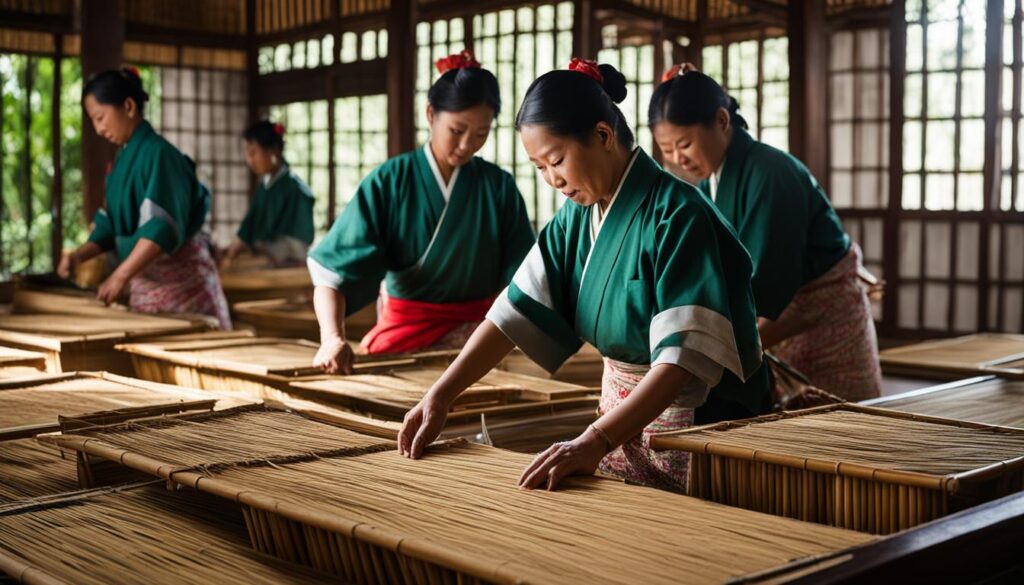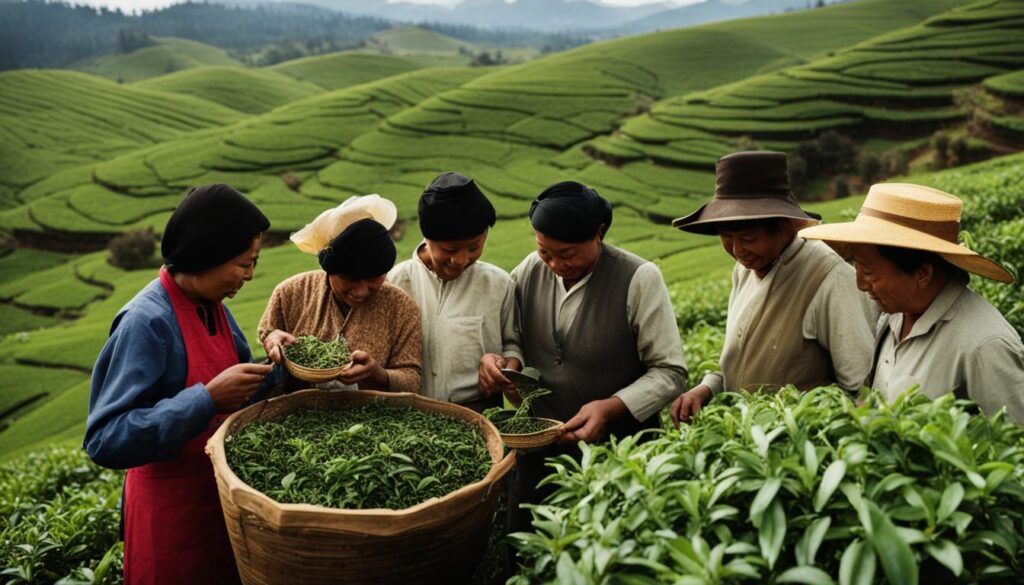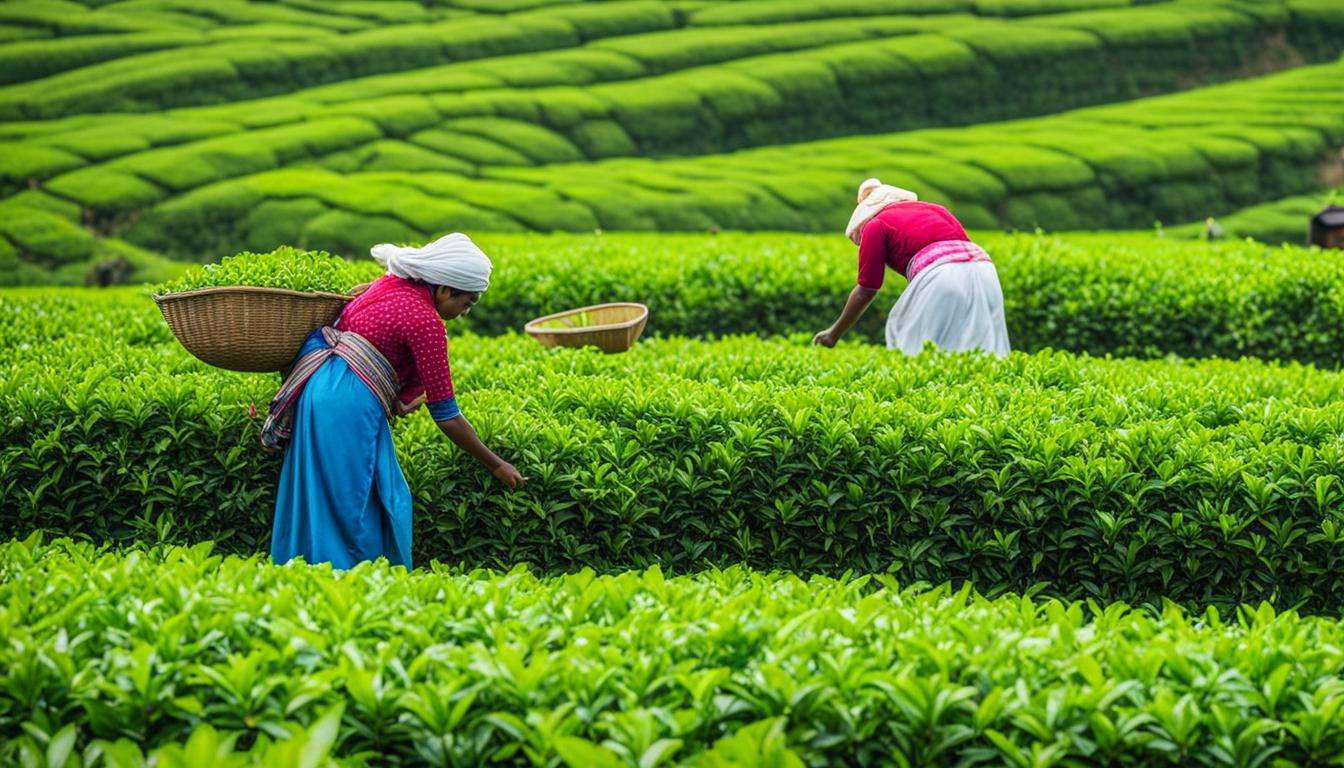Tea is a beloved beverage enjoyed worldwide, but have you ever stopped to consider the fascinating journey it takes from leaf to cup? From the cultivation of tea plants to the meticulous processing and manufacturing, the global tea production process involves a series of intricate steps that contribute to the final product we enjoy. Let’s explore the tea journey across continents and delve into the various stages that bring tea from the lush fields to your warm mug.
Key Takeaways:
- The tea production process involves intricate steps that contribute to the final product we enjoy.
- Tea cultivation varies across continents, with different farming methods and harvesting practices employed worldwide.
- Tea processing techniques, such as withering, rolling, oxidation, and firing, play a significant role in determining the flavor, aroma, and appearance of the final tea product.
- There are various types of tea available, each with its own unique characteristics and production methods.
- Alberta’s tea producers craft unique and flavorful teas, infusing locally sourced ingredients and herbs to create truly Albertan teas.
Tea Cultivation and Harvesting
Tea cultivation is a precise and delicate process that begins with selecting the perfect climates and conditions for tea plants to thrive. These plants flourish in warm and humid environments, requiring several years to reach their full maturity. Skilled farmers meticulously hand-pick the tea leaves, ensuring only the highest quality leaves make their way to tea factories for further processing. It is fascinating to note that tea cultivation methods and leaf-picking practices vary across continents, reflecting the unique traditions and techniques employed by tea farmers worldwide.
Throughout the globe, different tea farming methods have evolved to suit each region’s distinct climate and terrain. In some areas, tea plants are grown in vast plantations, covering expansive landscapes. These global tea plantations contribute significantly to the tea industry, supplying a substantial portion of the world’s tea production. Whether it is the terraced tea gardens of China or the sprawling estates in India, each tea-growing region imparts its own character and flavor to the final tea product.
Tea leaf picking practices also play a crucial role in the overall tea production process. The timing of the harvest and the skillful handpicking of the leaves greatly influence the quality and taste of the tea. Farmers carefully select the most tender and vibrant leaves, ensuring that only the freshest and most flavorful ones are chosen. This attention to detail ensures that every cup of tea brewed from these hand-picked leaves is a true delight to the senses.
The art of tea cultivation and harvesting is a testament to the dedication and expertise of farmers around the world. By carefully nurturing tea plants and handpicking the leaves, they contribute to the rich tapestry of teas we enjoy today. This intricate process sets the foundation for the subsequent stages of tea production, where the leaves undergo various processing techniques to transform them into the beloved beverage we know and love.
Tea Processing Techniques
Tea processing is a crucial stage in the tea production process. After the leaves are harvested, they undergo a series of steps to transform them into the desired tea type. The processing techniques may vary depending on the type of tea being produced, but common steps include withering, rolling, oxidation, and firing. These processes play a significant role in determining the flavor, aroma, and appearance of the final tea product.
The first step in tea processing is withering, where the freshly harvested tea leaves are spread out and left to wilt. This allows moisture to evaporate, making the leaves more pliable for further processing. The withering process can be done naturally or with the help of machines, depending on the scale of production.
Next, the withered leaves are rolled, which helps break down the cell walls and initiate oxidation. Rolling can be done by hand or using specialized machines, and it helps shape the leaves and release the enzymes responsible for oxidation.
Oxidation is a crucial step in tea processing, as it determines the level of oxidation and the resulting flavor profile. For black tea, the leaves are fully oxidized, resulting in a robust and rich flavor. Green tea, on the other hand, undergoes minimal oxidation, retaining its vibrant green color and fresh taste. Oolong tea falls somewhere in between, with partial oxidation leading to complex and nuanced flavors.
After oxidation, the tea leaves are fired, which stops the oxidation process and removes excess moisture. The firing step can be done through various methods such as pan-firing, steaming, or baking, depending on the tea type and regional traditions. This final step helps lock in the flavors and ensures the tea leaves are dry and ready for packaging.

Tea Processing Techniques Table
| Tea Type | Withering | Rolling | Oxidation | Firing |
|---|---|---|---|---|
| Black Tea | Natural or machine-assisted withering | Rolled by hand or machine | Fully oxidized | Pan-fired or baked |
| Green Tea | Natural or machine-assisted withering | Rolled by hand or machine | Minimal oxidation | Steamed or pan-fired |
| Oolong Tea | Natural or machine-assisted withering | Rolled by hand or machine | Partial oxidation | Baked or pan-fired |
These tea processing techniques highlight the craftsmanship and expertise required to produce a wide variety of teas. From the delicate handling of leaves during withering to the precise control of oxidation levels, every step contributes to the unique characteristics of each tea type. The flavor, aroma, and appearance of the final product are a testament to the skill and artistry of tea producers worldwide.
Types of Tea
When it comes to tea, there is a wide variety of types to choose from, each with its own distinct flavor and characteristics. Let’s explore some of the most popular types of tea:
Black Tea
Black tea is fully oxidized and known for its rich and robust flavor. It is often enjoyed with milk or sugar and has a deep amber color. Some popular varieties of black tea include Assam, Darjeeling, and Earl Grey.
Green Tea
Green tea is lightly oxidized and has a fresh, grassy taste. It is known for its numerous health benefits and is often enjoyed plain or with a hint of honey. Green tea varieties include Matcha, Sencha, and Gunpowder.
Oolong Tea
Oolong tea falls between black tea and green tea in terms of oxidation. It has a complex flavor profile, ranging from floral and fruity to nutty and toasty. Oolong tea is popular in Chinese and Taiwanese cultures and is often enjoyed in multiple infusions.
White Tea
White tea is made from the youngest tea leaves and buds, which are carefully harvested and minimally processed. It has a delicate, subtle flavor and a pale yellow color. Silver Needle and Bai Mu Dan are well-known varieties of white tea.
Herbal Tea
Herbal tea, also known as tisane, is not made from the Camellia sinensis plant but rather from a variety of herbs, flowers, and spices. It comes in various flavors and is often enjoyed for its calming and soothing properties. Some popular herbal teas include chamomile, peppermint, and rooibos.
| Type of Tea | Flavor | Oxidation Level | Popular Varieties |
|---|---|---|---|
| Black Tea | Rich, robust | Fully oxidized | Assam, Darjeeling, Earl Grey |
| Green Tea | Fresh, grassy | Lightly oxidized | Matcha, Sencha, Gunpowder |
| Oolong Tea | Complex, floral, nutty | Partially oxidized | Tie Guan Yin, Da Hong Pao, Oriental Beauty |
| White Tea | Delicate, subtle | Minimal oxidation | Silver Needle, Bai Mu Dan |
| Herbal Tea | Varies (depending on ingredients) | Non-caffeinated | Chamomile, Peppermint, Rooibos |
“Tea is the ultimate therapy for the mind and body. It’s a delicious way to explore different flavors and enjoy a moment of calm amidst the chaos of everyday life.”
Whether you prefer a strong and robust black tea or a light and refreshing green tea, there is a type of tea to suit every palate. With its diverse range of flavors and health benefits, tea truly offers something for everyone. So why not indulge in a warm cup of your favorite tea and savor the moment?
The Craft of Alberta’s Tea Producers
Alberta boasts a thriving tea industry with dedicated producers who excel in the craft of blending, infusing, and brewing teas. These artisans are passionate about creating unique and unforgettable tea experiences that reflect the essence of Alberta. By carefully selecting high-quality ingredients sourced locally, they are able to produce teas that capture the flavors and spirit of the region.

One of the most notable aspects of Alberta’s tea industry is the art of craft tea blending. Tea producers in Alberta take pride in their ability to curate exquisite blends by combining different types of tea leaves with locally grown herbs and botanicals. This expertise in blending allows them to create teas with complex and harmonious flavors that cater to the diverse tastes of tea enthusiasts.
In addition to craft tea blending, Alberta’s tea producers also specialize in the art of local tea infusion. They take inspiration from the natural beauty and abundance of Alberta’s landscapes to infuse their teas with unique flavors. Whether it’s incorporating wild berries from the Rocky Mountains or using prairie flowers as accents, these producers truly embrace the local terroir and deliver teas that are distinctly Albertan.
Artisan Tea Brewing
Artisan tea brewing is another hallmark of Alberta’s tea industry. Tea producers in the region are known for their meticulous attention to detail and their commitment to brewing tea in a way that enhances its flavors and aromas. From selecting the ideal water temperature to steeping the tea for the perfect amount of time, these artisans ensure that every cup of tea they serve is a delight to the senses.
“Tea is a craft that requires both knowledge and passion. We take pride in our ability to blend, infuse, and brew teas that showcase the best of Alberta’s natural resources. Every cup of tea we produce is a labor of love, and we are dedicated to providing tea enthusiasts with unique and exceptional tea experiences.”
The tea industry in Alberta continues to grow, attracting both locals and visitors who appreciate the artistry and craftsmanship behind each cup of tea. As tea lovers embrace the local tea scene, support local tea producers, and savor the diverse flavors and experiences that Alberta’s teas offer, they become part of a thriving community that fosters the growth and success of the Alberta tea industry.
| Alberta Tea Producers | Craft Tea Blending | Local Tea Infusion | Artisan Tea Brewing | Alberta Tea Industry |
|---|---|---|---|---|
| Passionate artisans dedicated to producing unique teas | Expertise in blending different tea leaves with local herbs | Inspired by Alberta’s landscapes to infuse teas with unique flavors | Meticulous attention to detail in brewing techniques | A thriving industry that continues to grow |
Embracing the Local Tea Scene
Alberta’s tea culture is a vibrant and exciting world, with a growing number of tea enthusiasts immersing themselves in the local tea scene. From charming teahouses in Edmonton, Calgary, and Lethbridge to bustling tea festivals that celebrate the art of tea, there are abundant opportunities to indulge in high-quality brews and support local tea producers.
When it comes to experiencing the delights of Alberta’s tea culture, there is no shortage of options. Local tea houses provide cozy and welcoming spaces where tea lovers can gather, enjoy a variety of teas from around the world, and engage in conversations about the intricacies of tea brewing. Whether you prefer a traditional British-style tea, an exotic blend from distant lands, or a comforting herbal infusion, Alberta’s tea houses offer a wide range of choices to satisfy every palate.
Tea festivals are another highlight of Alberta’s tea scene, bringing together tea enthusiasts, connoisseurs, and tea producers under one roof. These events showcase the diversity of tea, allowing attendees to sample an array of teas, attend informative workshops, and learn from industry experts. Tea festivals also provide a platform for local tea producers to shine, offering a unique opportunity to support and appreciate their craft.
One of the gems of Alberta’s tea industry is Gems of Alberta, a renowned retailer that specializes in local and artisanal teas. By choosing to buy from local retailers like Gems of Alberta, tea lovers can directly contribute to the growth and success of the Alberta tea industry while enjoying unique and exceptional teas. Supporting local tea producers not only ensures the sustainability of the local tea scene but also fosters a sense of community and pride in Alberta’s tea culture.
Conclusion
The Alberta Tea Journey is a remarkable exploration of the world of tea, from leaf to cup. As we’ve discovered, the careful cultivation and harvesting of tea plants, followed by the precise processing techniques employed, are essential in creating the diverse flavors and experiences that tea has to offer. By embracing the local tea scene in Alberta, we not only support the local tea industry but also gain a deeper appreciation for the craftsmanship and artistry behind each cup of tea.
Supporting our local tea producers is a wonderful way to contribute to the growth and success of the Alberta tea industry. By purchasing craft teas from retailers like Gems of Alberta, we can directly impact the livelihoods of tea artisans and ensure the continuation of their exceptional teas. And let’s not forget the pleasure of sipping a well-crafted cup of tea – it’s a true delight that can be savored and cherished.
So let’s raise our teacups to the Alberta tea journey, supporting our local tea industry, and appreciating the unparalleled tea craftsmanship. As we continue to explore and indulge in the world of tea, let’s remember the dedicated individuals behind each blend and the passion they pour into their craft. Together, we can help the Alberta tea industry thrive and enjoy the wonderful flavors and experiences that tea brings into our lives.
FAQ
How is tea cultivated and harvested?
Tea plants are carefully selected for suitable climates and conditions. Skilled farmers hand-pick the tea leaves when they are mature, and the leaves are then transported to tea factories for further processing.
What are the processing techniques involved in tea production?
After the tea leaves are harvested, they undergo steps like withering, rolling, oxidation, and firing to transform them into the desired type of tea. These processes determine the flavor, aroma, and appearance of the final tea product.
What are the different types of tea?
There are various types of tea, including black tea (fully oxidized), green tea (lightly oxidized), oolong tea (partially oxidized), white tea (made from the youngest leaves and buds), and herbal tea (made from herbs and flowers).
Tell me more about Alberta’s tea producers.
Alberta’s tea producers craft unique and flavorful teas using locally sourced ingredients and herbs. They blend these with the base tea leaves, creating teas that reflect the region’s terroir and showcase the skill and passion of Alberta’s tea artisans.
How can I embrace the local tea scene in Alberta?
You can explore the charming teahouses in Edmonton, Calgary, and Lethbridge, attend tea festivals that celebrate the craft, and support local tea producers by buying craft teas from retailers like Gems of Alberta. This way, you can enjoy exceptional teas while contributing to the growth of the Alberta tea industry.





